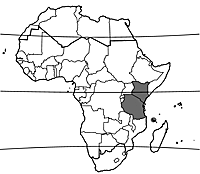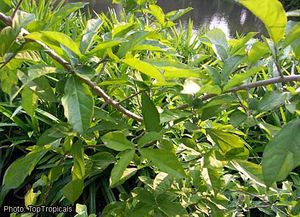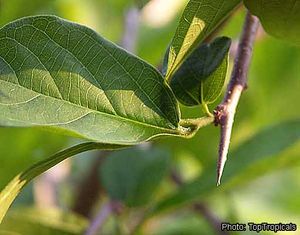Alangium salviifolium (PROTA)
Introduction |
| General importance | |
| Geographic coverage Africa | |
| Geographic coverage World | |
| Medicinal | |
| Timber | |
| Conservation status | |
Alangium salviifolium (L.f.) Wangerin
- Protologue: Engl., Pflanzenr. IV. 220b: 9 (1910).
- Family: Alangiaceae (APG: Cornaceae)
- Chromosome number: n = 9, 11, 2n = 16
Synonyms
- Alangium lamarckii Thwaites (1859).
Vernacular names
- Sage-leaved alangium (En).
Origin and geographic distribution
In tropical Africa Alangium salviifolium occurs in eastern Kenya, eastern Tanzania and Comoros. It is widespread in tropical Asia, from India to China, Thailand, the Philippines, Indonesia and Papua New Guinea.
Uses
The stems are used for spears in Kenya. In India the wood is valued for musical instruments and furniture. In Asia Alangium wood is used in building as beams, for flooring, furniture, cabinet work, inlaying, carving, bobbins, spindles, shuttles, rice pestles, tool handles, walking sticks, gunstocks and handicraft articles. The twigs are used for brushing the teeth in India.
In Comoros a decoction of the whole plant together with the fruit of coconut palm is used externally for the treatment of boils. Various parts of the plant are used in traditional medicine in India. The stem is used to cure diarrhoea and vomiting. The leaves are used to cure asthma and as cataplasm to reduce rheumatic pains. The fruit is used as purgative, expectorant, carminative and as an antidote for poisoning, and fruit juice is applied to cure eye diseases. The roots are used as a purgative, to expel worms, and to cure piles, hypertension, diarrhoea, fever, back pain, blood disorders, snake and rat bites, leprosy and other skin diseases.
In India a mixture of mature fruits of Alangium salviifolium with honey and rootstocks of sweet flag (Acorus calamus L.) is used to manage pests on agricultural crops.
Properties
The density of Alangium wood from Asia varies widely from 440–1100 kg/m³ at 15% moisture content,; it air dries well without checking, works well, bends easily and takes a good finish. The wood is not durable and should not be used for exterior purposes, especially when in contact with the ground.
The alkaloid alangine has been isolated from Alangium salviifolium; this compound acts on the parasympathetic nervous system. Other alkaloids, including cephaline, emetine and psychotrine, have also been isolated. Tests on immature male rats showed that the administration of alkaloids isolated from the stem bark resulted in a significant increase in the weight of testis, seminal vesicles, ventral prostate and epididymis. Leaf and wood extracts showed antifungal activity. The compounds 1-methyl-1H-pyrimidine-2,4-dione and 3–0-β-D-glucopyranosyl-(24β)-ethylcholesta-5,22,25-triene have been extracted from the flowers; they showed significant activity against a number of Gram-positive and Gram-negative bacteria.
Description
- Deciduous shrub or small to medium-sized tree up to 18 m tall; bark surface rough and pale brown; twigs grey or purple-brown, glabrous or pubescent, often with spines up to 12 mm long.
- Leaves alternate, simple, without stipules; petiole up to 1.5 cm long, hairy; blade elliptical to obovate, oblong or lanceolate, 3–23 cm × 1.5–9 cm, base cuneate or rounded, apex rounded to obtuse or acute, 3–9-veined from base.
- Inflorescence an axillary cyme, sessile or nearly so, golden-brown pubescent, 1–17-flowered.
- Flowers bisexual, regular, 5–10-merous, white, cream with a slight orange tinge, fragrant; buds cylindrical; pedicel 2–8 mm long; calyx tube urn-shaped, 1–2.5 mm long, lobes triangular, up to 1.5 mm long; petals strap-shaped, 12–28.5 mm × 1–2.5 mm, densely pubescent outside, glabrous or pubescent inside; stamens 10–32, 5–14 mm long; ovary inferior, 1–2-celled, style 8.5–27.5 mm long, glabrous, stigma conical or head-shaped, slightly lobed.
- Fruit an ellipsoid drupe 9–22.5 mm long, purplish, pubescent, 1-seeded.
- Seeds albuminous.
Other botanical information
The development of the tree is according to Roux’s architectural model, characterized by a continuously growing monopodial trunk with plagiotropic branches. Flowering of Alangium salviifolium in Kenya may be triggered by dry conditions created by low river levels rather than low rainfall. In East Africa trees flower in October–November, and fruits mature a few months later. In India the tree exhibits leaf shedding, flowering, fruiting and the development of new leaves during the dry season. Flowers are pollinated mainly by birds and bees, and seeds are dispersed by birds.
Alangium comprises about 25 species, most of them occurring in South-East Asia. In tropical Africa 2 species are indigenous, both of which are widespread outside Africa.
Ecology
Alangium salviifolium is found in lowland rainforest and riverine forest up to 750 m altitude.
Management
Alangium salviifolium can be propagated by seed and is reported to have a fairly good natural regeneration.
Genetic resources
In Africa Alangium salviifolium may be liable to genetic erosion because its distribution area is limited and it occurs in a threatened habitat. Considering its whole area of distribution, it is a variable species and research is warranted on its genetic constitution and infraspecific classification.
Prospects
A number of compounds extracted from Alangium salviifolium from Asia have shown antibacterial, antifungal and androgenic activities, without obvious toxicity. The potential of developing herbal medicines for the treatment of infertility and diseases caused by fungi and bacteria could be explored, also in Africa. In addition, the allelopathic potential of Alangium salviifolium in agricultural crops could be further investigated.
Major references
- Adeeba Anjum, Haque, M.E., Rahman, M.M. & Sarker, S.D., 2002. Antibacterial compounds from the flowers of Alangium salviifolium. Fitoterapia 73(6): 526–528.
- Beentje, H.J., 1994. Kenya trees, shrubs and lianas. National Museums of Kenya, Nairobi, Kenya. 722 pp.
- Mosaddik, M.A., Kabir, K.E. & Parvez Hassan, 2000. Antibacterial activity of Alangium salviifolium flowers. Fitoterapia 71(4): 447–449.
- Murugan, V., Gulhane, S., Badami, S., Ramanathan, M. & Suresh, B., 2002. Androgenic activity of the total alkaloid fraction of Alangium salviifolium (Linn. f). Journal of Natural Remedies 2(1): 66–70.
- Verdcourt, B., 1958. Alangiaceae. In: Turrill, W.B. & Milne-Redhead, E. (Editors). Flora of Tropical East Africa. Crown Agents for Oversea Governments and Administrations, London, United Kingdom. 4 pp.
Other references
- Adjanohoun, E.J., Aké Assi, L., Ali Ahmed, Eymé, J., Guinko, S., Kayonga, A., Keita, A. & Lebras, M. (Editors), 1982. Médecine traditionelle et pharmacopée - Contribution aux études ethnobotaniques et floristiques aux Comores. Agence de Coopération Culturelle et Technique, Paris, France. 217 pp.
- Ganesan, N., Ramar Pandi & Banumathy, N., 2007. Ethnomedicinal survey of Alagarkoil hills (reserved forest), Tamil Nadu, India. Electronic Journal of Indian Medicine 1:1–19.
- Ignacimuthu, S., Ayyanar, M. & Sankara Sivaraman, K., 2006. Ethnobotanical investigations among tribes in Madurai District of Tamil Nadu (India). Journal of Ethnobiology and Ethnomedicine 2(25): 1–7.
- Kinnaird, M.F., 1992. Phenology of flowering and fruiting of an east African riverine forest ecosystem. Biotropica 24(2 Part a): 187–194.
- Pankag, O., 2003. Ankol (Alangium lamarkii) as medicinal herb in Chhattisgarh, India. Research Note. [Internet] Record from Botanical.com. http://www.botanical.com/ site/column_poudhia/ 90_ankol.html . November, 2008.
- Phengklai, C., 1998. Alangium Lamk. In: Sosef, M.S.M., Hong, L.T. & Prawirohatmodjo, S. (Editors). Plant Resources of South-East Asia No 5(3). Timber trees: Lesser-known timbers. Backhuys Publishers, Leiden, Netherlands. pp. 55–58.
- Raju, A.J.S., Rao, S.P. & Rangaiah, K., 2005. Bird-mediated pollination and seed dispersal in a deciduous tree species, Alangium salviifolium (L.f. ) Wangerin (Alangiaceae) in the subtropical Eastern Ghats forests of India. Journal of the National Taiwan Museum 58(1): 69–82.
- Wuthi-udomlert, M., Prathanturarug, S. & Wongkrajang, Y., 2002. Antifungal activity and local toxicity study of Alangium salviifolium subsp. hexapetalum. Southeast Asian Journal of Tropical Medicine and Public Health 33, Suppl 3: 152–154.
- Xavier, T.F., Kalaiselvi, V., Kandhasamy, M., Rajakumari, M.P., Srinivasan, K. & Natarajan, D., 2005. Antifungal activity of leaf extracts of Alangium salviifolium. Journal of Tropical Medicinal Plants 6(2): 179–182.
Author(s)
- E. Ebanyenle, Forestry Research Institute of Ghana (FORIG), KNUST, University, P.O. Box 63, Kumasi, Ghana
Correct citation of this article
Ebanyenle, E., 2009. Alangium salviifolium (L.f.) Wangerin. In: Lemmens, R.H.M.J., Louppe, D. & Oteng-Amoako, A.A. (Editors). PROTA (Plant Resources of Tropical Africa / Ressources végétales de l’Afrique tropicale), Wageningen, Netherlands. Accessed 3 June 2025.
- See the Prota4U database.




